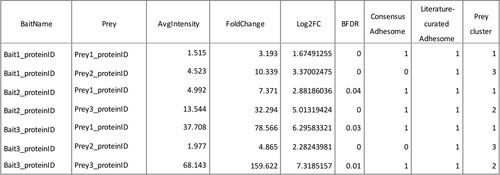下载PDF
{"title":"Multiplexed Proximity Biotinylation Coupled to Mass Spectrometry for Defining Integrin Adhesion Complexes","authors":"Megan R. Chastney, Craig Lawless, Martin J. Humphries","doi":"10.1002/cpcb.113","DOIUrl":null,"url":null,"abstract":"<p>BioID, a proximity biotinylation technique, offers a valuable approach to examine the interactions occurring within protein complexes that complements traditional protein biochemical methods. BioID has various advantages that are beneficial to the study of complexes, including an ability to detect insoluble and transient proteins. We have applied BioID to the study of integrin adhesion complexes (IACs), which are located at the junction between the plasma membrane and actin cytoskeleton. The use of multiple BioID baits enables a complex-wide, spatial annotation of IACs, which in turn facilitates the detection of novel proximal interactors and provides insights into IAC architecture. This article describes the labeling and affinity purification of IAC-proximal proteins and their analysis by label-free quantitative mass spectrometry. The article also outlines steps to identify high-confidence proximity interactors, and to interrogate the topology and functional relevance of proximity interaction networks through bioinformatic analyses. © 2020 The Authors.</p><p><b>Basic Protocol 1</b>: Proximity biotinylation of integrin adhesion complex components</p><p><b>Basic Protocol 2</b>: Mass spectrometry data processing by MaxQuant and detection of high-confidence proximal interactors</p><p><b>Basic Protocol 3</b>: Bioinformatic analysis and data visualization</p>","PeriodicalId":40051,"journal":{"name":"Current Protocols in Cell Biology","volume":"88 1","pages":""},"PeriodicalIF":0.0000,"publicationDate":"2020-08-24","publicationTypes":"Journal Article","fieldsOfStudy":null,"isOpenAccess":false,"openAccessPdf":"https://sci-hub-pdf.com/10.1002/cpcb.113","citationCount":"4","resultStr":null,"platform":"Semanticscholar","paperid":null,"PeriodicalName":"Current Protocols in Cell Biology","FirstCategoryId":"1085","ListUrlMain":"https://onlinelibrary.wiley.com/doi/10.1002/cpcb.113","RegionNum":0,"RegionCategory":null,"ArticlePicture":[],"TitleCN":null,"AbstractTextCN":null,"PMCID":null,"EPubDate":"","PubModel":"","JCR":"Q3","JCRName":"Biochemistry, Genetics and Molecular Biology","Score":null,"Total":0}
引用次数: 4
引用
批量引用
Abstract
BioID, a proximity biotinylation technique, offers a valuable approach to examine the interactions occurring within protein complexes that complements traditional protein biochemical methods. BioID has various advantages that are beneficial to the study of complexes, including an ability to detect insoluble and transient proteins. We have applied BioID to the study of integrin adhesion complexes (IACs), which are located at the junction between the plasma membrane and actin cytoskeleton. The use of multiple BioID baits enables a complex-wide, spatial annotation of IACs, which in turn facilitates the detection of novel proximal interactors and provides insights into IAC architecture. This article describes the labeling and affinity purification of IAC-proximal proteins and their analysis by label-free quantitative mass spectrometry. The article also outlines steps to identify high-confidence proximity interactors, and to interrogate the topology and functional relevance of proximity interaction networks through bioinformatic analyses. © 2020 The Authors.
Basic Protocol 1 : Proximity biotinylation of integrin adhesion complex components
Basic Protocol 2 : Mass spectrometry data processing by MaxQuant and detection of high-confidence proximal interactors
Basic Protocol 3 : Bioinformatic analysis and data visualization
多重接近生物素化耦合质谱法定义整合素粘附复合物
BioID是一种接近生物素化技术,提供了一种有价值的方法来检查蛋白质复合物内发生的相互作用,补充了传统的蛋白质生化方法。BioID具有多种优势,有利于复合物的研究,包括检测不溶性和瞬态蛋白质的能力。我们已经将BioID应用于整合素粘附复合物(IACs)的研究,它位于质膜和肌动蛋白细胞骨架之间的连接处。使用多个BioID诱饵可以对IAC进行复杂的空间注释,这反过来又促进了对新的近端相互作用物的检测,并提供了对IAC结构的见解。本文介绍了iac -近端蛋白的标记和亲和纯化及其无标记定量质谱分析。本文还概述了识别高置信度邻近相互作用的步骤,并通过生物信息学分析询问邻近相互作用网络的拓扑结构和功能相关性。©2020作者。基本方案1:整合素粘附复合物组分的邻近生物素化基本方案2:MaxQuant质谱数据处理和高置信度近端相互作用因子的检测基本方案3:生物信息学分析和数据可视化
本文章由计算机程序翻译,如有差异,请以英文原文为准。



